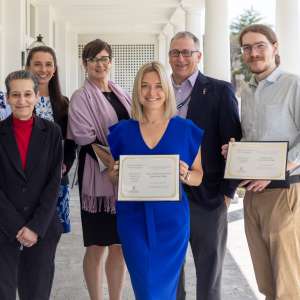KSC Journalism in the Spotlight
The Keene State journalism department is getting its own place in the press spotlight. In a recent New England Newspaper and Press Association (NEN&PA) article, four New England Schools discussed how they are preparing their students for a career in the newsroom. Rose Kundanis, journalism department chair represented Keene State College. The other highlighted programs included professors at Boston University, Northeastern University, and the University of Rhode Island. We sat down with Kundanis to talk about how Keene’s department is adapting to a digital age.
Kundanis told NEN&PA that “[At Keene State we] have a strong print journalism component, but digital [media] is in some way a factor in every course.” Within their first year, students begin with a course entitled “Writing for the Media.” This helps provide an overview for beginning journalists, and Kundanis added she includes an online writing component in her courses. Students are also encouraged to publish their portfolio online. The department also requires separate courses in broadcast, digital, and print journalism class. These individual courses allow for a more in-depth look at each of these types of journalism.
The department is changing to make sure that students have the opportunity to gain hands-on experience with cameras and editing. Additional curriculum changes include a revised editor’s course that includes a wide variety of multimedia projects. Social media is also an important component, and this fall a new course completely focusing on online journalism will be available. Students can also sign up for a recently added multimedia journalism minor. This will include required courses in multimedia and photojournalism, and students will be able to work on “additional kinds of projects that wouldn’t necessarily be print oriented,” Kundanis says. There is also the opportunity to work with TV production and broadcast journalism through the Keene State College TV network.
Even with the implementation of hands-on experience, Kundanis also highlights how students gain insight within the classroom. In 21st Century Journalism Models, students are introduced to different communication theories and technologies. At its essence, these courses are looking at how the relationship between technology and journalists has changed over the years. Kundanis also points to the fact students are “looking at a variety of successful and unsuccessful models.” From these examples, students learn how to effectively create newscasts and write articles that will catch the public eye.
Yet, with new technology and journalism styles, these courses still convey traditional skills like fact checking and the art of storytelling. Also important is learning to ask the write questions and learning to identify what qualifies as news. In today’s society, “news is a very specific kind of information, so it isn’t the same (type of information) as whatever you find online,” Kundanis says. Students also start off learning about in-the-field reporting: writing about their community and what’s happening. “Students get a digital audio recorder and they go out, and they don’t just go on-campus. They go out into the city of Keene and they talk to people,” Kundanis says.
But adapting for a new style of journalism isn’t the only planned changes for the Keene State journalism department. Kundanis says she and other faculty have worked to expand journalism internship opportunities for students and recent graduates. The changing landscape of journalism is allowing for more opportunities through online newspaper platforms. The concept of this media is emerging; students can write from their home or while at school and gain experience that way. “I continue to get these calls that say ‘We’re beginning to do this start up, it’s online, and people can work out of their homes,’” Kundanis says. This new platform of digital reporting and writing is opening up a whole new field for KSC students. Kundanis adds that three students have joined an all-online sports reporting network, and a recent graduate is working with Patch.com, a community news site. There’s also opportunity within more traditional outlets ¬– one student is spending his summer at Fox News in Boston focusing on social media and online work.
The department is also looking to possibly expand the editor’s course to include another type of journalism: entrepreneurial journalism. Emerging with the new digital age, this new approach has journalists working on both the business and news angle of the newsroom. “(You see) a real push and real growth area in terms of these entrepreneurial approaches. You can see examples of it in NH Public Radio, where one of our alums who was an editor for years, made the switch to NH Public Radio and works the fundraiser,” Kundanis says. This mixture of news and numbers is something that the journalism department is looking to add in the curriculum so current students can add one more item to their skill set.
Despite changes to the industry, KSC Journalism alumni work in a variety of platforms, from print to radio and fully online papers. They’ve also created a network for current students – “We have a strong alumni involvement. We have people in the field who are very willing to comeback to talk to the current students, and that’s a real gift,” according to Kundanis.
Written by Jessica Lulka ‘14, who is interning with the Marketing & Communications Office.





